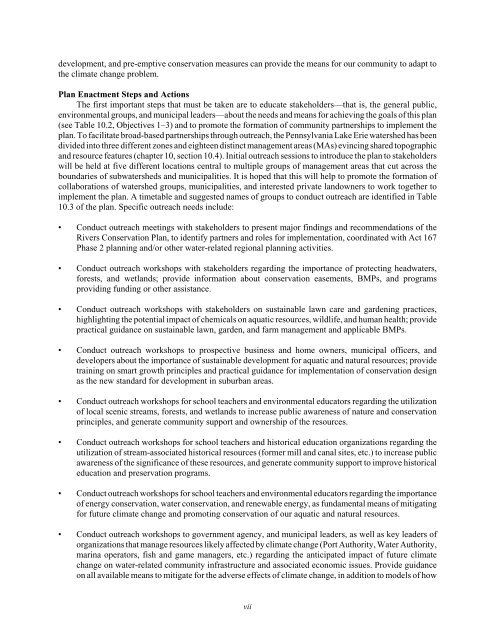Watershed Conservation Plan - Destination Erie
Watershed Conservation Plan - Destination Erie
Watershed Conservation Plan - Destination Erie
You also want an ePaper? Increase the reach of your titles
YUMPU automatically turns print PDFs into web optimized ePapers that Google loves.
development, and pre-emptive conservation measures can provide the means for our community to adapt to<br />
the climate change problem.<br />
<strong>Plan</strong> Enactment Steps and Actions<br />
The first important steps that must be taken are to educate stakeholders—that is, the general public,<br />
environmental groups, and municipal leaders—about the needs and means for achieving the goals of this plan<br />
(see Table 10.2, Objectives 1–3) and to promote the formation of community partnerships to implement the<br />
plan. To facilitate broad-based partnerships through outreach, the Pennsylvania Lake <strong>Erie</strong> watershed has been<br />
divided into three different zones and eighteen distinct management areas (MAs) evincing shared topographic<br />
and resource features (chapter 10, section 10.4). Initial outreach sessions to introduce the plan to stakeholders<br />
will be held at five different locations central to multiple groups of management areas that cut across the<br />
boundaries of subwatersheds and municipalities. It is hoped that this will help to promote the formation of<br />
collaborations of watershed groups, municipalities, and interested private landowners to work together to<br />
implement the plan. A timetable and suggested names of groups to conduct outreach are identified in Table<br />
10.3 of the plan. Specific outreach needs include:<br />
• Conduct outreach meetings with stakeholders to present major findings and recommendations of the<br />
Rivers <strong>Conservation</strong> <strong>Plan</strong>, to identify partners and roles for implementation, coordinated with Act 167<br />
Phase 2 planning and/or other water-related regional planning activities.<br />
• Conduct outreach workshops with stakeholders regarding the importance of protecting headwaters,<br />
forests, and wetlands; provide information about conservation easements, BMPs, and programs<br />
providing funding or other assistance.<br />
• Conduct outreach workshops with stakeholders on sustainable lawn care and gardening practices,<br />
highlighting the potential impact of chemicals on aquatic resources, wildlife, and human health; provide<br />
practical guidance on sustainable lawn, garden, and farm management and applicable BMPs.<br />
• Conduct outreach workshops to prospective business and home owners, municipal officers, and<br />
developers about the importance of sustainable development for aquatic and natural resources; provide<br />
training on smart growth principles and practical guidance for implementation of conservation design<br />
as the new standard for development in suburban areas.<br />
• Conduct outreach workshops for school teachers and environmental educators regarding the utilization<br />
of local scenic streams, forests, and wetlands to increase public awareness of nature and conservation<br />
principles, and generate community support and ownership of the resources.<br />
• Conduct outreach workshops for school teachers and historical education organizations regarding the<br />
utilization of stream-associated historical resources (former mill and canal sites, etc.) to increase public<br />
awareness of the significance of these resources, and generate community support to improve historical<br />
education and preservation programs.<br />
• Conduct outreach workshops for school teachers and environmental educators regarding the importance<br />
of energy conservation, water conservation, and renewable energy, as fundamental means of mitigating<br />
for future climate change and promoting conservation of our aquatic and natural resources.<br />
• Conduct outreach workshops to government agency, and municipal leaders, as well as key leaders of<br />
organizations that manage resources likely affected by climate change (Port Authority, Water Authority,<br />
marina operators, fish and game managers, etc.) regarding the anticipated impact of future climate<br />
change on water-related community infrastructure and associated economic issues. Provide guidance<br />
on all available means to mitigate for the adverse effects of climate change, in addition to models of how<br />
vii





